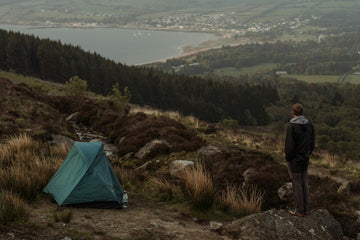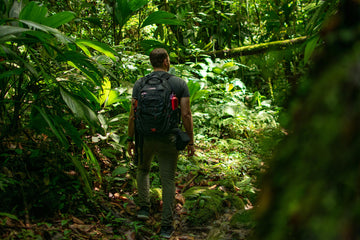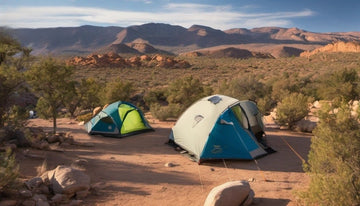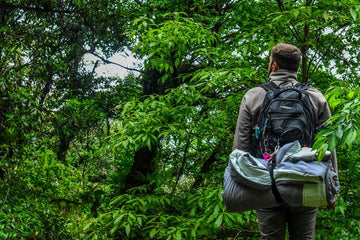
Do you yearn to grab your gear and experience nature without reserving a campsite or listening to your neighbor's radio?
Are you an outdoor gear enthusiast who wants to put your kit to the test? If you want to camp under the stars and away from crowds and lot numbers, dispersed camping should be your next camping experience.
What is Dispersed Camping?

Dispersed camping is camping in its base form. Adventure enthusiasts gravitate to this camping style because it requires less planning than other camping styles and puts you in the woods and feeling like a true explorer. Often called Free camping, Boondocking, or Roughing it, dispersed camping is camping without amenities. Rather than paying to hook up your camper to power or set up at a designated picnic table and fire pit, you are camping off the grid. Dispersed camping includes backpack camping as well as car camping and overlanding.
Advantages and Challenges of Dispersed Camping
Life or camping is what you make it. Dispersed camping has phenomenal benefits and a few challenges, but what is a camping trip without a few challenges? One easy advantage is that dispersed camping is usually free. There are some exceptions to this rule in areas that limit the number of backcountry campers, such as western national parks. However, most areas that permit dispersed camping do so at no cost. With no cost, no specific spots can be reserved or taken. Getting to explore and seek out a suitable campsite is a task that many campers enjoy. For some, especially as new, finding a spot can be daunting. Being removed from the crowds is one of the biggest perks. While you won't have to worry about noisy neighbors, you must be self-sufficient. Dispersed camping means there won't be any power, water, or restrooms.How to Camp Dispersed?
As mentioned earlier, camping dispersed is much more freeform than other camping styles; the only rule, outside of basic camping ethics, is that it should happen in an area where dispersed camping is permitted. Yes, it's true that you can stake out and explore the wilderness as your heart desires, but camping in national parks is often regulated. Luckily for the free camping adventurer, BLM (Bureau of Land Management) and US Forrest Lands permit dispersed camping in most of their land. Even better, more often than not, these public lands border parks, making them ideal areas to camp at night and still enjoy the vistas and trails of the parks, all for less money. All that is needed is a quick verification of whether the area allows camping. Speaking to a ranger or officer BEFORE setting up camp is much easier than discussing after the fact. Several apps and forums are dedicated to helping narrow your search and providing locations to camp. Some of these include:- OnX
- Sēkr
- www.boondocking.org
- Campendium.com
- freecampsites.net
Campers should note that not all states or lands have the same camping rules. States like Pennsylvania require campers to have a free permit to camp on state lands.
Ethical Guidelines for Dispersed Camping
Regardless of the style, the basic ethics of camping apply. These can be summed up with one phrase: "Leave no trace." The Leave No Trace mantra consists of 7 tenets, these are:- Plan ahead and prepare- Knowing where you are going and what you need to get there will reduce the risk of needing rescue and the impacts of trailblazing.
- Travel and camp on durable surfaces- Stick to trails when able and avoid walking on living or soft terrain.
- Dispose of waste properly- There will be no toilets or trashcans while camping. Dig a cathole 100 feet or more from a water source, and take your trash with you when you leave.
- Leave what you find- Take only photos and memories; our public lands are for everyone's enjoyment.
-
Minimize campfire impacts- Use a cookstove to reduce fire risks whenever possible. Always verify that the fire pit is cold and the ashes are mixed to reduce the chance of embers igniting the area.

- Respect the wildlife- Don’t pet the fuzzy cows. Joking aside, practice catch and release while fishing and avoid disturbing animals for both parties' safety.
- Be considerate of others- Camp discreetly, and avoid blocking the trailhead or the road if vehicle camping.
Selecting Suitable Dispersed Camping Locations
Once you have found the general area you plan on camping in, it's time to select a couple of camping locations to scope out. We suggest finding a few spots since the requirements below may sway your choice when you are finally ready to set up your tent. Tying into the camping ethics listed earlier, finding areas used by other campers is best practice. Whether you are overlanding or hiking, the logic is still the same. Selecting a precleared camp with a fire circle or pit already set up reduces the impact on the area by shrinking the overall footprint of campers. Fewer cleared tent areas and new paths allow the environment to function as it should and keep the beauty of these wild places intact.Find level ground. Ground with decent drainage, especially in the rainy seasons, can be the difference between a comfortable night and a day of wet gear.
Vehicle campers or those looking to drive to the trailhead should follow the trail. Only pull off or drive on areas that are already driven on.

Always camp on bare soil. Doing so reduces the damage to local plant life. Bare soil also is less likely to harbor ticks, ants, and snakes, none of which are pleasant bedfellows.
Camp at least 100 feet away from any water source. This distance is to prevent erosion and contamination.
National forests require that dispersed roadside campsites stay within a certain distance from a roadway. However, these distances differ from one location to another. For example, the Sawtooth National Forest permits require that sites be up to 300 feet from a road, while Utah’s Fishlake National Forest allows camping within 150 feet of a road.
Essential Gear Checklist for Dispersed Camping
Self-sufficiency is the name of the game when it comes to packing camping gear for a dispersed trip. The price we pay for getting away from the crowds of other campers is that we sacrifice the amenities that come with established campsites. No two campers and no two trips will be the same, so consider this list to be the essentials.- Water- pack or provide a gallon per person per day and a backup water filtration system.
- Food- If camping with a vehicle, you can keep some perishable food cold; otherwise, freeze-dried or shelf-stable foods are your meal choices.
- Tent- Unless you are in a campervan or RV and can sleep in the vehicle, you will need a tent. A sleeping bag and mattress pad are also needed.
- Maps/ GPS- Don't assume that your phone will have service while camping. While a GPS is ideal, a non-powered option is also wise.
- Garbage bags- Remember to pack out what you pack in.
- Shovel- A hand trowel is adequate for digging catholes for latrine use. It also comes in handy when making a trench around your tent.
- Bear canisters or odor-proof bags- If the location is in bear country and without bear lockers, a canister or way to keep food out of a bear's paws is required.
- Safety items include a whistle, compass, flashlight, knife, a tire repair kit, and a first aid kit with daily medication.
- Power- Batteries, a power bank, or a solar charger are a smart idea to keep your lights and devices running.

Dispersed camping is nature exploration in its best form. Escaping from the hustle and bustle of commercial campgrounds while taking in nature's serenity and wonder is why we camp. The planning, excitement, and few dollars saved by free camping are all further indicators that this style of camping deserves more recognition. Whether you are roughing it in the Big Cypress in Florida or boondocking BLM land near Joshua Tree, the thrill of leaving no trace while creating memories is an experience every adventure enthusiast longs for. So pack your bag, charge your flashlight, and find a spot off the beaten path. Go dispersed camping, and be free.
Learn more: Let's Get Camping: A Beginner's Guide to Outdoor Adventures
Related Articles





